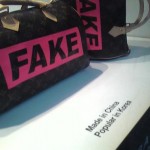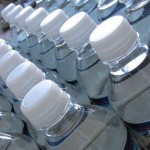 I recently purchased a pair of authentic Vintage Versace sunglasses online and was amazed at the number of fake designer sunglasses and handbags advertised on the internet. In fact, there are more videos and websites dedicated to promoting and avoiding counterfeit products than there are sites selling genuine designer items.
I recently purchased a pair of authentic Vintage Versace sunglasses online and was amazed at the number of fake designer sunglasses and handbags advertised on the internet. In fact, there are more videos and websites dedicated to promoting and avoiding counterfeit products than there are sites selling genuine designer items.
What does this tell you?
The market for rip offs and counterfeit items is huge. According to fashionistas, editors and bloggers in the industry, the total spending on fake or “knock-off” designer goods eclipses the amount actually spent on the real thing. In fact, if you see someone on the street with a Versace, Hermes or Fendi bag, there’s only a 1 in 100 chance that it’s authentic. Customers prefer replicas.
So how does this impact you and your business?
Unfortunately, many consumers would rather invest a little to give the appearance that they appreciate quality. The fakes are inferior, but many customers choose them anyway because they want to maintain a facade. They want the quick fix – the easy path to looking successful but few want to make the necessary investment of time and money, required to BE successful.
In order to stand out in a marketplace where imitations and charlatans are plentiful, you need to do the opposite of what your competition is doing.
Where their message is confusing, yours must be simple.
When they are selling features and benefits, you must present the solution.
Where they are focused on their brand, you must identify your customer’s pain and cure it.
Where their claims are unsubstantiated, yours must be tangible.
There will always be a long list of vendors and products to satisfy the insatiable appetite for “almost authentic”. And in the end, the purchaser will always get exactly what they paid for. If you continue to compete based on price alone (or intangible claims), 99% of your customers will continue to assume that you are not the real deal either.
Rest assured, your potential customer will continue to be in pain no matter which replicas and quick fixes she purchases in the meantime. Eventually, the pain will become so acute that she will seek out your genuine solution. Make it easier for her to find you by having a clear message that helps her to decide and say “Yes.” Help her to know that you are authentic – put a fair price on what you do, provide tangible proof your solution works and then deliver on your promise.
Solutions are like diamonds, precious and rare. Fakes are like dry leaves in the fall, found everywhere.
Article Source: http://EzineArticles.com/6586136
What do you think of Google’s answer to the Facebook “like” button – the “Google +1 for business”?
The Google +1 for business is Google speak for making search more social and to combat that growing omnipotence of Facebook. The Google +1 for business feature allows users to vote +1 on search results they find useful, and to share that preference with their connections in Google chat, Gmail, Google Reader, Google Buzz and Twitter. Users are already amassing and viewing the total number of +1 votes and the names of their contacts who have posted their preferences.
If you caught the last 60 Minutes interview with Mark Zuckerberg, it was reported that Faceook has overtaken Google in terms of preference for web search and page views. Facebook also reports that an astounding 75% of its users log in every single day and many people use it actively to research products and companies – not by viewing their websites but by looking at what their friends have to say about these brands and businesses.
Seems like in addition to SEO, pay-per-click and content marketing, we now have an even more powerful web optimization formula – it’s called “He Said/She Said” – and you don’t need to be a tech guru or an advertising specialist to figure that one out! Before you make a new purchase or try out some new cloud application, do you just do a Google search or are you now also relying on the recommendations and experiences of your social media network?
Google has been all knowing and all powerful in the area of internet search for quite some time – heaven help you if you did something to influence your SEO ranking and they didn’t “like it”. They could wipe you off the world wide web map by dropping you down to page 99 and their was nothing you could do about it. Times sure have changed… Google may not be the #1 employer of choice for IT experts anymore- some believe it has lost more senior managers and IT developers to Facebook (than any other single company) in the past year.
The way I see it, Google must innovate now (and Google +1 for business is just one example) or it will surely go the way of Altavistsa. I know, I know… some of you Gen Y’s out there are saying Alta- who? Enough said.
18 Sep 2011
Is Bottled Water Making You Stupid?
Bottled water is THE most profitable drink product in the world, selling for 3000 to 9000 times what you pay for the perfectly safe, inexpensive liquid that comes out of your tap at home.
To put this in context, paying $2.40-3.90 for a 750ml bottle of water is equivalent to:
• $10,000 for a tuna sandwich at your local cafe or
• A bill from your water company this month for $3000/tonne of water (as opposed to the going rate of $1.2/tonne)
According to the Australasian Bottled Water Institute, Australians consume over 250 million litres a year at a price of $385 million. We have been systematically brainwashed by the beverage industry to believe that our tap water is somehow unsafe or insufficient – look around and you will see that there are now hundreds of brands competing for your attention with clever marketing campaigns designed to scare, seduce and mislead you to part with your hard earned money.
Despite its association with prestige, purity and pristine conditions, bottled water is often no better than tap water (in terms of taste and cleanliness) and the production process it is extremely harmful to our environment.
Did you know that:
• For every 250 million litres of bottled water, it takes 125million litres of oil to produce the plastic bottles, refrigerate and ship them from one part of the world to another
• For every litre of bottled water sold, another 2 litres are used up in the production process
• More than ½ of the brands on the market are derived from municipal water supplies, despite the fact that the packaging would lead us to believe they come from unspoiled mountain streams or underground springs
• Over 80% of the bottles end up in landfills and are never recycled
It is estimated that bottled water has become a more than $45 billion dollar industry worldwide. Surprisingly, 97% of it is consumed in countries which have plentiful sources of clean, safe drinking water. We can afford to turn our noses up, avoid the tap and fork out millions for bottled water: our choice however is purely a lifestyle one. A lifestyle choice for us with life and death consequences for others and our planet.
For 2.6 billion people in the developing world, lack of clean water and basic sanitation is a life or death situation. It is estimated that half of the people in the developing world are suffering from diseases associated with inadequate water or sanitation and that 5 million people die each year. According to the International Water Management Institute, clean water and improved sanitation could be provided to everyone on earth for an outlay of $11 billion a year (less than a quarter of our global $45 million spending on bottled water), yet to date, there has been no impetus to re-channel the money and change our thinking on this important issue.
So you may be sitting there and thinking, what does this mean for YOU and your business?
Well, nothing… and yet perhaps, everything.
How often have you (or someone else in your team) said:
• “if we had more money, we could invest in X and improve our business?”
• “if we put our prices up by 10%, we will lose customers.” or
• “we can’t afford to buy X because it’s too expensive.”
You already have enough money to do and buy all of the things that you need – it’s simply a matter of common sense and priorities. We are all affluent in this country: It is your mindset and your language which is lacking, not your bank account.
In fact, each and every day you and I waste money by overpaying for bottled water and other convenience/impulse items. We rarely stop to think about the true value of what we got vs. what we paid. Bottled water is just one obvious example and it is not difficult to see how this might be playing out in other areas of our lives.
You and I have happily overpaid for products. Yet we struggle to charge what we are worth or put our prices up because we fear that no one will buy. Isn’t that interesting?
Perhaps you and I need to take a lesson from the bottled beverage industry and focus on how we are marketing and selling our products/services? Is fear more powerful than selling benefits? Is perception more influential than reality? Are you seducing your customers with sizzle or merely putting them to sleep with your low prices?
Think about it. Beverage companies have managed to package and sell to us something that is practically free and plentifully abundant, for thousands of times what it is worth. And up until now, we have all paid willingly. Bottled water has in fact made us all look a bit foolish.
Maybe it’s not the price you are charging that is the problem? It’s the way you are choosing to promote your product/service. The best time to change your mindset and your approach is now. Anything is possible.
Article Source: http://EzineArticles.com/4936397
Media outlets constantly search for stories and people who will captivate the attention of their audiences. What this means for you and your organization is that today is the best time to reach out and earn your share of the millions in free publicity that is available every single day.
How do you impress the media and stick out in a sea of wannabes?
First and foremost, don’t waste their valuable time. Virtually, every media outlet is operating with fewer staff than they had last year. This means that they still have the same pressing deadlines and space to fill but they don’t have enough staff to do it.
If you want your pitch to stand out amongst the thousands that hit their inbox today – it has to be memorable, relevant and thorough.
Here are my TOP 4 Tips to guarantee you attract attention no matter what product or service you are selling.
1. Be Newsworthy. You can never hope to “make the news” if you have no idea what is going on in the news. The media is not interested in your product or service. What they are interested in are celebrities, politicians, sports stars, scandals, natural disasters and other headline news. If you want to be featured, you need to make what you do relevant in the context of what is happening today in the news. Tie what you do to someone or something that is newsworthy and you will become the go-to-expert for top shows, magazines and newspapers.
2. Tailor Your Story. If you don’t read a particular publication or follow a show, chances are that it will be almost impossible for you to hit the target with the editor or producer. They get thousands of pitches every day – if it doesn’t fit squarely within what they do, they will simply toss it in the garbage. It is better to send out 2 custom pitches a day that are carefully crafted than 100 generic emails or faxes that are too broad to appeal to anyone.
3. Create your own news. The other day I got a call from a national news organization who read my pitch that 1/3 of the population suffers from insomnia. They immediately wanted to interview me. Now, insomnia has been around since the beginning of time. Why did it become a pressing national news story on Tuesday at 9am in Melbourne? 1/3 of the general population is a lot of people. If something affects a lot of people, it becomes newsworthy. The trick to garnering media attention is to take some aspect of what you do and make it tangible and real (as a problem) to the lives of many.
4. Follow the story and add to it. If you watch carefully you will notice that the media tends to follow a hot story for an extended period of time. Take for example Claire Werbeloff, the chick-chick-boom girl, who became a Youtube sensation around the world for lying about the events leading up to a Kings Cross murder. Even though she had no talent, connection to the crime or evidence, we were forced to endure more than 4 weeks of national coverage on her (not the crime). She eventually went on to be featured in Ralph magazine and was offered work with Channel 9. To emulate this you need to track the pulse of hot news stories and be on the lookout for opportunities to enhance the coverage by contributing insights and expert commentary. When it comes to breaking news, the media is on the look-out for related subjects which add to the story or new angles that are fresh and captivating.
Media outlets capture eyeballs with news and they are not in the business of selling your products or services. By following the news and becoming newsworthy, you will increase your chances exponentially of being picked up and featured.
The good news is that media outlets are constantly searching for stories and people who will capture and captivate the attention of their audiences. What this means for you and your organization is that right now (TODAY) is the best time for you to reach out and earn some of the millions of dollars of free publicity that is available every day.
Article Source: http://EzineArticles.com/3142180
11 Sep 2011
Is Anger a Symptom of Depression?
Many people believe that depression can result from anger turned inwards. Anger and depression are simply states of mind just like sadness, frustration, confusion etc. Yet many people mistakenly ask the question “is anger a symptom of depression”?
Anger does not cause (nor is it a symptom of depression). In my clinical experience, persistent anger does often co-exist with MANY other negative emotions – frustration, despair etc. However, in assisting clients to release these deeply ingrained patterns of negative emotions, it is often necessary to work with and release anger first as it is a strong, dominant, primary emotion. Often, unless anger is released first, it is impossible to face or address the underlying issue(s).
However, I do not believe anger causes or is a symptom of depression per se.
Depression often presents when a person is constantly worried about problems they perceive they have no control over. It results from a tendency to focus exclusively on the negative – thought, spoken word, physiology etc. Like anger, depression is not something that happens to us – it can be created and exacerbated by our thoughts, words and physiology over time. Over long periods of time, it is possible to develop a habit of being angry all the time and/or a habit of being depressed.
Statistics prove that the majority of us focus more of our attention on what we don’t want (or are afraid of) and we tend to do it with passion! Science has already proven that anything we do with strong emotion and passion creates a deeper engram (impression) on our minds.
Changing deeply ingrained habits or repetitive states of mind (whether they be positive or negative) requires repetitive autosuggestion over a period of at least 21 days. This fact was discovered in the 60’s by a plastic surgeon named Maxwell Maltz.
What this means is that we are always in control of our experience of the world – our emotions, our meanings and the habits we develop over time. No one causes us to feel angry or depressed. It is something that we choose to do ourselves, in response to our life experiences. The good news is that we can take responsibility and “unchoose” the unproductive states of mind or habits….thereby changing forever our results and our destiny.












